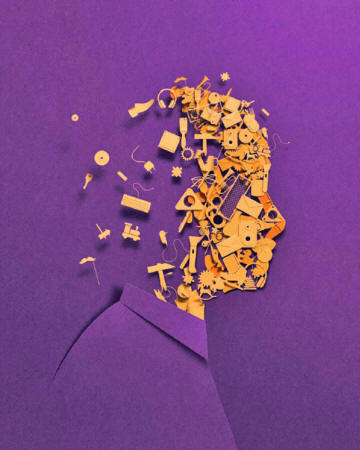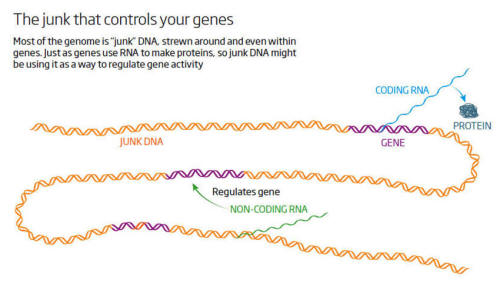|
July 30, 2016 from Sci-Hub Website
Start with a load of old junk, says Colin Barras
You are junk:
Why it's not your genes that
make you human - that was the received wisdom. But from big brains to opposable thumbs, some of our signature traits could come from elsewhere
At the dawn of the new millennium, two rival teams were vying to be the first to sequence the human genome. Their findings, published in February 2001, made headlines around the world.
Back-of-the-envelope calculations had suggested that to account for the sheer complexity of human biology, our genome should contain roughly 100,000 genes. The estimate was wildly off.
Both groups put the actual figure at around 30,000.
We now think it is even fewer - just 20,000 or so.
We've only gradually come to grasp the full implications of this discovery.
The blueprint for building a human, or indeed any complex creature, lies not only in our genes but in other, neglected parts of our genome. This long-overlooked DNA could have shaped iconic traits such as our upright stance, opposable thumbs, big brains, capacity for language, even our tendency to form monogamous relationships.
We might like to think of ourselves as
pinnacles of evolution, but actually we are mostly made of junk.
For a long time the rest was considered to have no function at all, earning it the dismissive title "junk DNA".
While researchers still argue over how
much of it truly is junk, what's clear is that this trash hides
treasure - bits of DNA that control genes like a conductor directing
an orchestra, switching them on and off at different times and in
different cells.
These discoveries have come from studies
comparing the human genome, junk and all, with those of chimps, mice
and other animals.
Seeking clues to what HACNS1 does, they inserted it into the genomes of mouse embryos, along with a tiny, molecular label that would change color whenever it was modifying the activity of surrounding genes. The label popped up in the embryos' paws, in the area where digit 1 forms.
In humans, that is either the thumb or
big toe, suggesting that HACNS1 might influence their development.
There is evidence that our ancestors
evolved opposable thumbs about 3 million years ago, roughly when
they began to use stone tools and only a few million years after we
split from chimpanzees.
NICOLAS NOTHUM/MILLENNIUM
IMAGES, UK
It's likely that early humans were also standing upright and were starting to walk on two legs around the same time or a little earlier.
Doing so was tied to physical changes:
toes shrank and foot arches became more rigid.
There are hints that junk DNA is
involved.
Andrew Sharp of the Icahn School of Medicine at Mount Sinai, New York, and his colleagues compared DNA methylation patterns in humans, chimps, gorillas and orangutans, and found 171 genes with uniquely human patterns.
A closer look suggested that these genes were involved in a handful of traits: regulating blood pressure, controlling the development of the inner ear and shaping facial muscles.
Walking upright lifted the brain, which meant our ancestors had to change how they regulated blood pressure to keep the brain supplied with enough oxygen. It also demanded exceptional balance, typically improved by modifying the inner ear.
Speech, meanwhile, required an unprecedented level of control over the muscles in our face and around our mouth.
"WHEN OUR ANCESTORS LOST THIS PIECE OF JUNK DNA, SUDDENLY BRAIN CELLS COULD PROLIFERATE"
Using the fact that bits of DNA carrying methyl groups degrade differently from bits that don't, the pair were able to reconstruct Neanderthal methylation patterns and compare them with human ones.
They found key differences in genes that control limb development.
That's an exciting finding, because we know that Neanderthals typically had shorter, stouter legs than we do.
So by switching some genes on or off,
and making them pump out different amounts of proteins, methylation
could have contributed to giving us longer legs than our extinct
cousins.
John Mattick, who is at the Garvan Institute of Medical Research in Sydney, Australia, thinks that junk DNA controls methylation.
He suggests cells might transcribe junk into RNA, molecules typically associated with the process of making proteins (see diagram, below right). But this "non-coding" RNA does something else:
That's plausible, says geneticist and
evolutionary biologist T. Ryan Gregory at the University of
Guelph in Ontario, Canada, and he agrees that non-coding RNA might
well be involved in managing methylation.
Some genes that are methylated
differently in humans compared with Neanderthals appear to be linked
to disease - including neurological and psychiatric disorders.
So is junk DNA what makes us human?
A link between junk DNA and illness makes sense to Mattick.
He likes to think of the genome as a set of organic building blocks. The proteins that genes code for are generic components that can be used to construct almost any animal.
Encoded in our junk DNA is a set of instructions for how to assemble them to make one species or another. The problem with instruction manuals is that they can get damaged.
And indeed, genetic diseases can often
be traced to non-coding "junk" regions of the genome.
For example, a team led by David Kingsley at Stanford University in California identified about 500 regions of our genome that are missing a chunk of genetic information which our primate relatives carry.
They focused on two, both found in non-coding regions:
They inserted chimp versions into mouse embryos and watched to see where they were most active.
The answer turned out to be the brain
and the groin.
When our ancestors lost this piece of DNA, he says, suddenly brain cells could proliferate at unprecedented rates and our brains got much bigger. More speculatively, the second sequence might have changed our ancestors' relationships. It was active in spines that are found on mouse penises.
The spines appear to play a role in species where several males compete for individual females:
No one really knows what they are for,
but if losing them made sex less painful, that might have
contributed to the creation of stronger emotional bonds between men
and women, boosting monogamous relationships.
But a new genetic megaproject could make
the case a lot stronger.
According to Jef Boeke at the New York University Langone Medical Center, one of the researchers behind the project, exploring the role of non-coding DNA will be among its most interesting applications.
As the team pieces together a complete human genome, they will be able to delete non-coding segments one by one and see how that affects cells, he says. That could lead to tangible benefits.
Renewed efforts to grow human organs in pigs, and so make up for the shortfall in organ donors, rely on injecting human stem cells into pig embryos. But exactly how those human cells manage to mature into a human organ inside a newborn piglet is still mysterious.
HGP-Write could help us understand
what's going on and finesse our organ-growing efforts.
The answers, it seems, are buried in
the trash...
|





